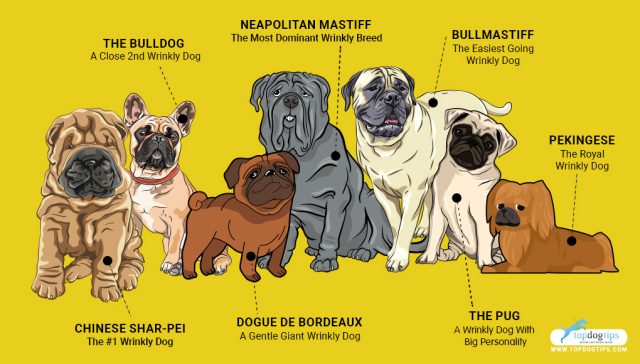
Table of Contents
There’s nothing better than seeing a super squishy, wrinkly dog face. For many pet owners, the extra skin gives their pup an incredible appearance that makes it easy for them to fall in love with. It’s important to remember that caring for a wrinkly dog breed isn’t the same as caring for a smooth-skinned dog, nor should it be treated as such.
In fact, daily maintenance is required to keep your wrinkly dog’s skin in pristine condition. It’s always helpful to research proper care before winding up with a nasty skin infection that you could have prevented.
Here are the top 7 wrinkly dog breeds and the level of care required to keep their wrinkles in top condition to help get you started.
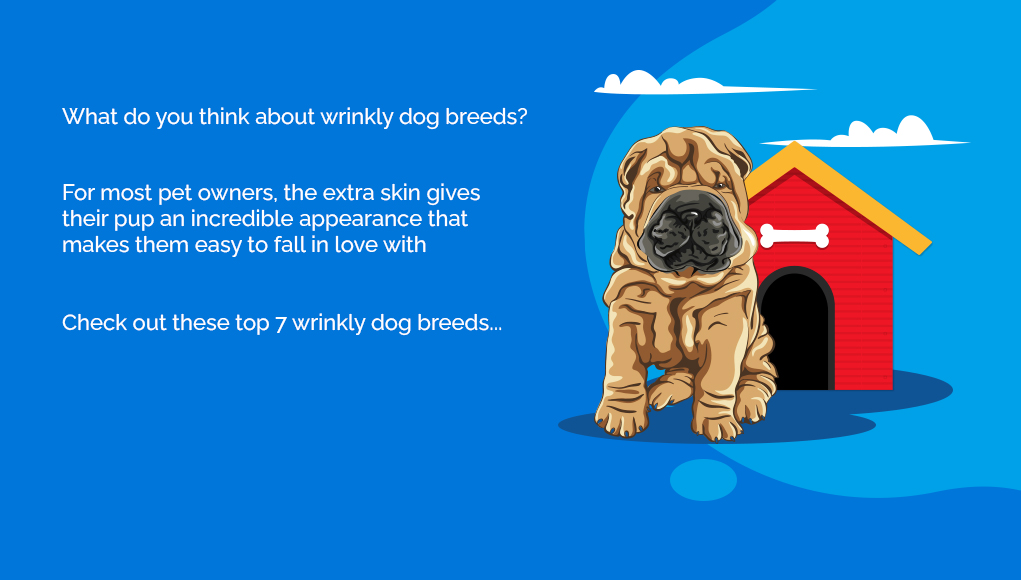
The 7 Cutest Wrinkly Dog Breeds
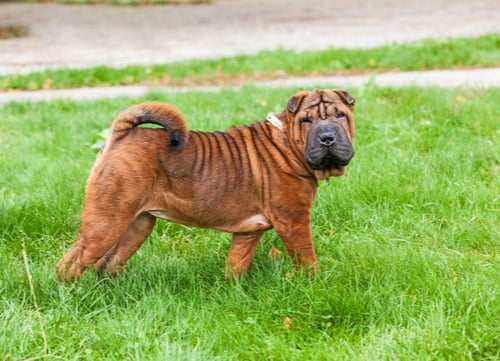
#1 Chinese Shar-Pei
Although this breed was once a guard dog and pit fighter, they are predominately companion animals now.
It’s important to remember that some character traits are still engrained in his DNA, making him hold on to the fighting toughness decades ago.
This pup can be aggressive toward dogs and people, making training important. Always make sure to socialize and train your Shar-Pei to limit the likelihood of this happening.
The Shar-Pei has a pretty easy-going demeanor, making him suitable for apartment living, although he can be on the vocal side.
As a guardian, this dog makes a fabulous watchdog. This wrinkly dog is very devoted, talking to his family; he can be quite stubborn and willful, meaning training can be difficult if not implemented immediately.
They do well with a distinct pack leader, which can limit the alpha tendencies.
From a hygiene perspective, this breed is relatively easy to handle. They are naturally clean, meaning bathing and grooming are minimal.
The wrinkles are prone to fungal infections, so it’s important to ensure that the creases are dried thoroughly after any water play or bathing attempts.
If you notice smells coming from your pup, grab a clean cloth and gently wipe down the wrinkles. Grab a towel and dry the wrinkles well after wiping them down.
If the smell persists, contact your dog’s veterinarian for further instructions on care.
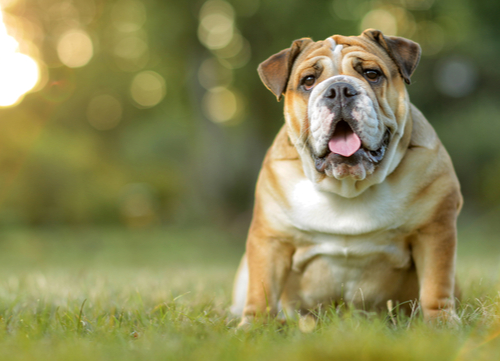
#2 Bulldog
Originally used to bring cattle to market, this gentle companion dog was once a competitor in a sport called bullbaiting.
This slow-moving, low-energy dog loves nothing more than a walk around the block and spending afternoons cuddled up on the couch.
Super affectionate and low maintenance, these dogs are perfect for families hoping to find a cuddly companion.
It’s important to remember that bulldogs are susceptible to extreme temperatures. They can’t tolerate humidity or heat, meaning they’re more likely to overheat and need access to well-shaded areas or water to cool down and regulate body temperatures.
They also struggle with cold weather and snow. Bulldogs can be particularly lazy, with a natural stubborn nature and desire to hang out and nap versus walking, running, and playing.
It’s important to give daily physical activity, especially as the weight can remain a struggle throughout their lives.
While this breed is quite a wrinkly dog, they’re mostly capable of staying clean. It’s important to wipe out their wrinkles daily with a dry paper towel or cloth.
Get rid of any “goop” that’s collected throughout the day. You’ll also want to clean the wrinkles with a wet cloth to help eliminate any dirt or debris, limiting the chance of infection.
If you notice a bad smell, they may have a fungal or bacterial infection. You’ll want to keep the area free of moisture, taking care to dry the folds well.
Make sure to use any antibiotics or anti-fungal creams as directed.
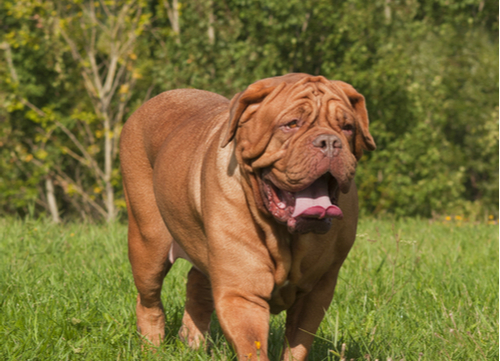
#3 Dogue de Bordeaux
Gaining popularity in the 1989 film Turner and Hooch, this self-assured, loyal, and occasionally territorial pup is a gentle giant with a big personality.
It’s important to get thorough and proper training early on to prevent future behavioral problems. With a trademark massive head, their loose jowls are known for slobber and drool.
They are naturally protective of their family unit but are docile and passive-natured.
Having a stubborn personality requires a pet parent who is willing to follow through with consistent training.
The Dogue de Bordeaux is a large breed dog, standing at 27 inches at the shoulder and a minimum of 110 pounds. Patience is required when handling this gentle giant, as his arrogant behavior can test any dog owner’s limits.
Early socialization is paramount for limiting aggression toward strangers and other dogs, with its territorial nature.
With loose jowls and lots of folds, this breed may need a bit of help with overall skincare. Bacteria and yeast both love warm, damp environments.
To help limit the likelihood of developing infection and sores, always take the time to clean the folds on their face properly.
Make sure to wipe down each layer of extra skin with a dry towel, taking care of the mouth, nose, and eye areas.
The Dogue de Bordeaux can have issues with their ears as well, so make sure to inspect these too regularly.
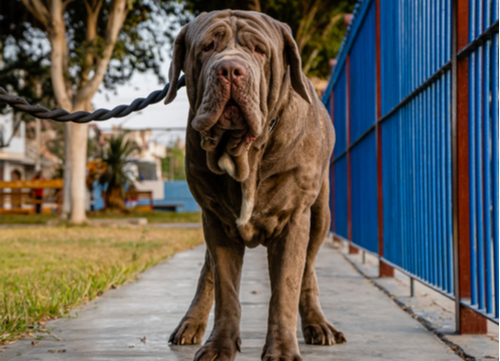
#4 Neapolitan Mastiff
Also known as the Neo, this dog is a massive breed with a big personality to match.
They require plenty of space and confident training techniques, making the Neapolitan Mastiff best suited to experienced dog owners.
With their large, dominating appearance, this breed often gets a few looks while walking down the street. Weighing in at over 200-pounds, this guardian is steady and loyal, with a strong connection to their family.
They’re not typically aggressive, but they absolutely will defend their family if provoked.
The Neapolitan Mastiff is not built for the faint at heart, with loose jowls that slobber regularly. In fact, these dogs can slobber extreme amounts when anxious, eating, or drinking.
They’re also known for passing gas, making them a smelly family member. Despite their slightly offensive habits, they are loyal dogs with a docile personality.
From a hygiene standpoint, the Neapolitan Mastiff is fairly low maintenance. Their coats are short, making occasional bathing required, but not expected.
The skin folds and wrinkles require consistent monitoring and cleaning to prevent infection, taking care to dry the folds carefully. This is especially true due to the slobber and drool.
Make sure to use a clean, soft cloth to clean the area daily, investing in a towel to carry around with you throughout the day for wipe-ups.
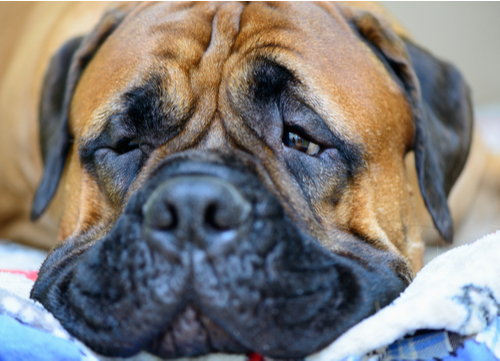
#5 Bullmastiff
Known as the silent watchdog, these dogs are fearless family guardians who connect with their families. They can be standoffish with strangers, but they can become confident and trustworthy with proper socialization and training.
As a large breed dog, these dogs are a wonderful deterrent for homes, despite the natural, easy-going nature. This wrinkly dog reaches a weight of 130 pounds. This dog is built solid.
The Bullmastiff is a naturally patient dog, making them a suitable match for homes with children, but be mindful of their size.
Their size can quickly become overwhelming to toddlers and small children, especially as they often don’t recognize their own size.
As such, it’s always important to monitor children with dogs. The Bullmastiff are okay being left alone (such as a working parent environment), provided they get enough attention when you return home from work.
They enjoy spending time outdoors, whether in a fenced-in yard or run, but are not designed to remain outdoors continuously. In fact, they are prone to heat exhaustion during humid and hot days.
Although the breed has a short, low-maintenance coat, the Bullmastiff does require a bit of help cleaning and drying the extra skin folds around his face.
This is particularly true as they tend to drool and slobber on occasion, making the folds susceptible to fungal infections on occasion.
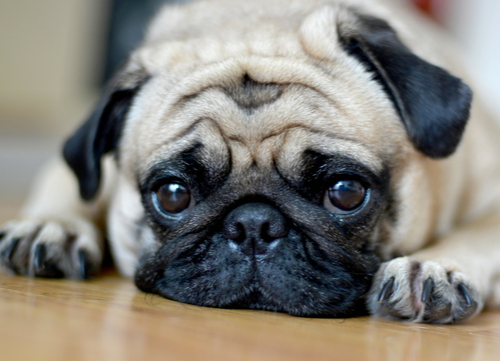
#6 Pug
Known for being the little dog with a big personality, the Pug is a sturdy companion designed to thrive on human companionship.
The Pug is known in the canine world as a clown. They have a huge sense of humor and enjoy using it. These pups are susceptible, enjoying time spent with their humans.
Please don’t leave the Pug alone for long. They don't like it. This wrinkly breed prefers to travel with its family whenever possible.
The Pug is ideal for novice or experienced dog owners alike, with an easy-going personality and a playful demeanor. You should note that this breed can be difficult to housebreak and often comes with a stubborn streak.
As such, consistent training is recommended, despite their small size. This breed is notorious for overeating, making them prone to obesity.
They love having fun and playing with their family, thriving on positive reinforcement whenever possible.
The Pug has a short coat that sheds a lot all year round. Shedding does become worse in spring and fall but can be maintained with regular brushing.
Their deep wrinkles on their face and pushed-in nose bring a trademark appearance that many find endearing. It’s important to keep these wrinkles dry and free of any debris or “goop.”
Use a dry, clean cloth to wipe down the dog’s face daily to ensure healthy skin conditions. If you notice a wet appearance or sour smell, contact your vet.
There’s a chance your Pug has developed a fungal infection from moisture sitting in the folds.
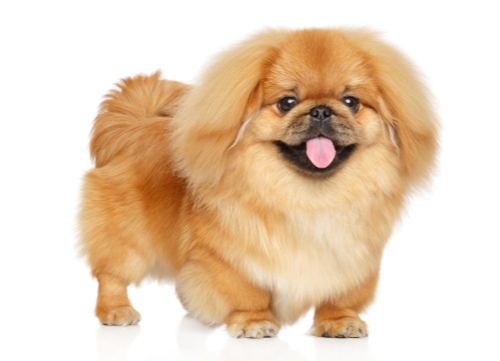
#7 Pekingese
Originally bred as cherished companions to the imperial family, the Pekingese are still loyal family members who treat everyone with dignity and grace.
Commonly called the Peke, these dogs are adaptable to almost any living environment, including apartments and new pet parents. They can be prone to barking, however, so training is important from an early age.
These dogs typically bond to one person in the family unit, remaining attached to them individually instead of a family animal.
Known for their intelligence, their stubborn streak and independence can make this breed difficult to train. They may consider any situation before performing, reminding you that the Pekingese will not be dominated.
The Pekingese can be loving toward their family but remain aloof with strangers. This characteristic makes them excellent watchdogs, alerting the family of any newcomer in the home.
The folds on the Pekingese’s face need care periodically, although not as frequently as some other breeds. Their long luxurious coats do require constant, daily care—especially with their long flowing coat.
You can keep the coat shorter to lessen the grooming requirements. Make sure to wipe the face down with a wet cloth, paying attention to any skin folds.
Always dry the area with a clean towel afterward to limit the growth of any fungus.
How to Identify Infections in Skin Folds of Wrinkly Dogs
Irritated skin folds and wrinkles aren’t uncommon, but they absolutely shouldn’t be considered normal, either.
Irritated skin can cause pain, discomfort, and itching; left unattended, it can quickly develop into an infection requiring antibiotics.
You should be able to identify when the wrinkle is irritated or infected, which is important.
It would be best if you did not allow moisture to get into a dog's skin fold. If the moisture is left for an extended period of time, bacteria and fungus are offered the perfect environment to grow.
As the bacteria grow, it can quickly develop into irritation. That’s why it’s important to clean out your dog’s wrinkles a few times a day. Pay attention to mealtimes, playtimes, or when playing outside.
Food, water, debris, and dirt can enter into the folds, which will also foster bacteria.
Final Thoughts
Initially, your dog may have a skin condition called dermatitis. Inflamed skin can develop into a serious skin infection.
If this happens, you may notice thick pus or slime developing between the folds. The folds may also develop a staph infection, which requires strong antibiotics to clear. In fact, most infections will get considerably worse if left untreated.
As always, prevention is easier for both your dog and your wallet. If you notice an inflamed or sticky area on your dog’s skin, you should always get it checked by a vet.
It would be best if you leave an infected area alone; always have it checked out.
Read Next: How to Keep a Dog Safe and Calm During Grooming and Cleaning













